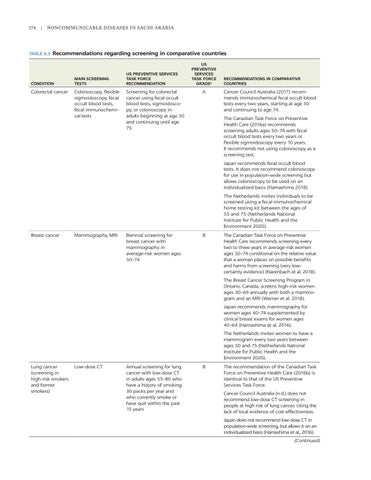174 | Noncommunicable Diseases in Saudi Arabia
TABLE 8.3 Recommendations
CONDITION
Colorectal cancer
regarding screening in comparative countries
MAIN SCREENING TESTS
Colonoscopy, flexible sigmoidoscopy, fecal occult blood tests, fecal immunochemical tests
US PREVENTIVE SERVICES TASK FORCE RECOMMENDATION
Screening for colorectal cancer using fecal occult blood tests, sigmoidoscopy, or colonoscopy in adults beginning at age 50 and continuing until age 75
US PREVENTIVE SERVICES TASK FORCE GRADEa
A
RECOMMENDATIONS IN COMPARATIVE COUNTRIES
Cancer Council Australia (2017) recommends immunochemical fecal occult blood tests every two years, starting at age 50 and continuing to age 74. The Canadian Task Force on Preventive Health Care (2016a) recommends screening adults ages 50–74 with fecal occult blood tests every two years or flexible sigmoidoscopy every 10 years. It recommends not using colonoscopy as a screening test. Japan recommends fecal occult blood tests. It does not recommend colonoscopy for use in population-wide screening but allows colonoscopy to be used on an individualized basis (Hamashima 2018). The Netherlands invites individuals to be screened using a fecal immunochemical home testing kit between the ages of 55 and 75 (Netherlands National Institute for Public Health and the Environment 2020).
Breast cancer
Mammography, MRI
Biennial screening for breast cancer with mammography in average-risk women ages 50–74
B
The Canadian Task Force on Preventive Health Care recommends screening every two to three years in average-risk women ages 50–74 conditional on the relative value that a woman places on possible benefits and harms from screening (very low- certainty evidence) (Klarenbach et al. 2018). The Breast Cancer Screening Program in Ontario, Canada, screens high-risk women ages 30–69 annually with both a mammogram and an MRI (Warner et al. 2018). Japan recommends mammography for women ages 40–74 supplemented by clinical breast exams for women ages 40–64 (Hamashima et al. 2016). The Netherlands invites women to have a mammogram every two years between ages 50 and 75 (Netherlands National Institute for Public Health and the Environment 2020).
Lung cancer (screening in high-risk smokers and former smokers)
Low-dose CT
Annual screening for lung cancer with low-dose CT in adults ages 55–80 who have a history of smoking 30 packs per year and who currently smoke or have quit within the past 15 years
B
The recommendation of the Canadian Task Force on Preventive Health Care (2016b) is identical to that of the US Preventive Services Task Force. Cancer Council Australia (n.d.) does not recommend low-dose CT screening in people at high risk of lung cancer, citing the lack of local evidence of cost-effectiveness. Japan does not recommend low-dose CT in population-wide screening, but allows it on an individualized basis (Hamashima et al., 2016). (Continued)

